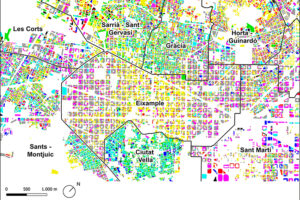
Monitoring odour episodes in Vacarisses
September 15, 2021
More efficient mechanical ventilation for intensive care patients
September 22, 2021Badalona City Council has commissioned the Acoustic and Mechanical Engineering Laboratory (LEAM) of the UPC’s CATMech research group to find technical alternatives for train noise reduction that do not involve the installation of acoustic panels in two stretches of the city’s Rambla de Santa Madrona. The panels were the solution proposed by the Administrator of Railway Infrastructures (ADIF).

After a meeting between Badalona Mayor Xavier Garcia Albiol, Director of the School of Engineering Esther Real and CatMech Researcher Jordi Romeu, held on 10 September, the UPC was commissioned to draw up a report to propose noise pollution reduction measures for trains. These measures must mitigate the sound impact by working on aspects such as the rail infrastructure, wheels and rails, which could be the cause of the noise.
The city council commissioned this study because the spaces affected by the installation of the screens are within the urban protection area of the Rambla, in the Badalona Heritage Catalogue, listed as a Cultural Asset of Local (BCIL). The screens would have a strong visual impact on the street and the affected buildings.
Technology
Topic
You want to know more?
Related Projects
- The La Volta project foresees the construction of a large Catalan vault pergola within the Llars Mundet campus, in the Montbau neighbourhood (Horta-Guinardó district). This structure will become a new architectural landmark for Barcelona, combining traditional construction techniques with contemporary innovation. The project involves the Rehabilitation and Architectural Restoration Research Group (REARQ), at the Universitat Politècnica de Catalunya - BarcelonaTech (UPC), and is led by the Architects’ Association of Catalonia (COAC) and the Barcelona Provincial Council.
- The Architecture, Energy and Environment (AiEM) research group at the Universitat Politècnica de Catalunya - BarcelonaTech (UPC) has characterised Barcelona’s residential buildings according to their capacity to adapt to climate change. This study is part of the project ‘VeUvE: Urban havens for vulnerable zones’. The work highlights the climate inequality conditions present across different areas of the city and will help to better define the priorities and energy renovation strategies for its districts.
- The Research Center for Supervision, Safety and Automatic Control (CS2AC-UPC) at the Universitat Politècnica de Catalunya - BarcelonaTech (UPC) has coordinated the SaCoAV project, focused on researching new methods and tools to ensure the safe coordination of autonomous vehicles in urban environments.
- The Centre for Technological Risk Studies (CERTEC) at UPC is participating in the WUITIPS project (Wildland-Urban-Interface Fire Touristic Infrastructure Protection Solutions), which aims to develop a new wildfire management framework for the tourism sector. This project contributes to risk analysis and the design of specific strategies to mitigate such risks.




